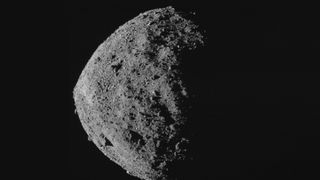
NASA's first asteroid-sampling mission is hauling its space-rock bounty home.
The OSIRIS-REx probe began heading for Earth today (May 10), kicking off a 1.4-billion-mile (2.3 billion kilometers) journey that will culminate with the touchdown of its sample capsule in the Utah desert in September 2023.
That capsule is full of pristine material that OSIRIS-REx collected from the near-Earth asteroid Bennu in October 2020. The spacecraft had been lingering near Bennu's patch of space until around 4 p.m. EDT (2000 GMT) today, when it fired its main thrusters for seven minutes.
The maneuver changed OSIRIS-REx's velocity by 595 mph (958 kph) — enough to set it on a circuitous new Earth-intersecting course that includes two more loops around the sun.
"I am so excited," Jodi Zareski, systems lead at Lockheed Martin Space, said today during a NASA webcast after receiving confirmation that the engine burn had started. (Lockheed Martin built OSIRIS-REx and operates it for NASA.) "I really wish Motley Crue was here so we could rock out to 'Home Sweet Home,' because we are bringing that sample back."
OSIRIS-REx: NASA's asteroid sample-return mission in pictures
Grabbing asteroid samples
The $800 million OSIRIS-REx mission launched in September 2016 and arrived at the 1,650-foot-wide (500 meters) Bennu in December 2018.
Get the Space.com Newsletter
Breaking space news, the latest updates on rocket launches, skywatching events and more!
The probe studied the carbon-rich space rock up close for a while, sizing it up and searching for the best place to spiral down and snag samples. OSIRIS-REx made that pivotal dive on Oct. 20, 2020, gathering a huge amount of asteroid dirt and gravel — so much, in fact, that the probe's sampling mechanism couldn't close properly.
Mission team members had planned to estimate the mass of the material by performing a spinning maneuver with the spacecraft shortly after sample collection. But the maneuver would likely have caused more Bennu bits to escape, so OSIRIS-REx stowed the stuff in its return capsule without doing the spin move.
As a result, we don't know exactly how much asteroid rubble is coming home. But it's safe to say that it comfortably exceeds the 2.1-ounce (60 grams) minimum targeted by the mission, OSIRIS-REx team members have said. It will therefore be the largest cosmic sample hauled to Earth by NASA since the Apollo astronauts brought home 842 lbs. (382 kilograms) of moon rocks from 1969 to 1972.
Bennu is a primitive, carbon-rich asteroid — the type that many scientists think helped deliver, via countless impacts, lots of water and organic material to the early Earth. After OSIRIS-REx's samples come home, researchers around the world will study them in depth, seeking clues to help answer some very big questions.
"We want to understand, how did Earth become a habitable planet? How were the seeds of life, those prebiotic organic materials, delivered to Earth that triggered the origin of life and evolution as we know it?" OSIRIS-REx principal investigator Dante Lauretta, of the University of Arizona, said during today's NASA webcast.
Bennu is also a potentially hazardous space rock, so the OSIRIS-REx mission has planetary-defense applications as well. For example, measurements made by the probe should help researchers better understand how asteroids move through space, refining the estimated trajectories of potentially Earth-threatening rocks, team members have said.
In addition, the mission could aid future space miners, letting them know how much water and other resources asteroids such as Bennu harbor. (The diverse objectives of the mission are laid out by its full name: "Origins, Spectral Interpretation, Resource Identification, Security-Regolith Explorer.")
Related: Potentially dangerous asteroids (images)
Mission navigation has received confirmation of burn cutoff. #OSIRISREx is headed home with a souvenir of rocks and dusts from a 4.5-billion-year-old asteroid! #ToBennuAndBack pic.twitter.com/BmaK1dkPDBMay 10, 2021
A sample-return golden age
OSIRIS-REx is just one of several sample-return missions that have launched in recent years.
For example, Japan's Hayabusa2 spacecraft returned pieces of Ryugu — like Bennu, a carbon-rich near-Earth asteroid — to Earth on Dec. 5, 2020. And a mere 11 days later, the sample capsule of China's Chang'e 5 moon mission came down in Inner Mongolia.
Hayabusa2 has now begun an extended mission that aims to study (but not sample) other asteroids, and a similar fate may await OSIRIS-REx. After releasing its return capsule on Sept. 24, 2023, the NASA probe will perform an engine burn to avoid slamming into Earth. It may then be sent on another deep-space trek — perhaps one that centers on a 2029 rendezvous with the potentially dangerous asteroid Apophis.
Mike Wall is the author of "Out There" (Grand Central Publishing, 2018; illustrated by Karl Tate), a book about the search for alien life. Follow him on Twitter @michaeldwall. Follow us on Twitter @Spacedotcom or Facebook.
Join our Space Forums to keep talking space on the latest missions, night sky and more! And if you have a news tip, correction or comment, let us know at: community@space.com.

Michael Wall is a Senior Space Writer with Space.com and joined the team in 2010. He primarily covers exoplanets, spaceflight and military space, but has been known to dabble in the space art beat. His book about the search for alien life, "Out There," was published on Nov. 13, 2018. Before becoming a science writer, Michael worked as a herpetologist and wildlife biologist. He has a Ph.D. in evolutionary biology from the University of Sydney, Australia, a bachelor's degree from the University of Arizona, and a graduate certificate in science writing from the University of California, Santa Cruz. To find out what his latest project is, you can follow Michael on Twitter.
